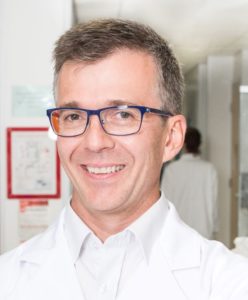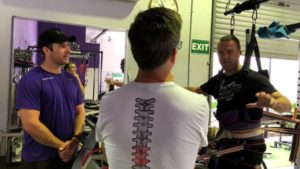
Professor James St John
Griffith University is seeking five people living with spinal cord injury to be part of stage two of an innovative trial which will test intensive rehabilitation for those living with chronic spinal cord paralysis.
Head of the Clem Jones Centre for Neurobiology and Stem Cell Research Professor James St John said the ultimate goal is to help people suffering from a spinal cord injury to regain motor, sensory and autonomic function.
“This can mean many different things to different patients,” Professor St John said.
“It could be regaining the ability to breathe independently of a machine, regaining bladder and bowel function, or it could be the ability to regain function of a limb.”
The rehabilitation trial aims to determine how people respond to a program of intensive long-term rehabilitation.

Professor James St John with Jim Barrett, Director of Making Strides and client Mick Chisholm
This trial is an important precursor of a bigger future trial that is being planned which involves the transplantation of cells to repair the injury site.
Testing the rehabilitation component is needed to ensure the best chance of success for the bigger trial.
The overall cell transplantation plus rehabilitation therapy that the team in the Clem Jones Centre is developing uses a 3D nerve bridge produced with specialised cells called olfactory ensheathing cells which normally support the nerve cells responsible for the sense of smell.
These cells are excellent candidates for transplantation to repair other regions of the nervous system including the spinal cord.
The cells are retrieved through a simple biopsy of the internal lining of the nostrils before the cells are purified and then used to generate nerve bridges.
The nerve bridges are created using a newly invented in-house production technique.
Once the nerve bridges are implanted into the injury site, they create a permissive glial bridge which enables the nerve cells within the spinal cord to grow across the injury site leading to restoration of neural connectivity.
Professor St John said the cell transplantation alone is not enough as stimulation of activity is needed to get the cells to make the correct connections.
“For this reason, patients will also undergo an intensive rehabilitation program both prior to and after transplantation,” he said.
“However, as intensive rehabilitation for people living with chronic spinal cord injury is not routinely available in Australia, the team needs to first test the rehabilitation program.
“For the current rehab trial, participants will undergo two hours of exercise plus 30 minutes of functional electrical stimulation each day, five days a week for 16 weeks.
“It’s a lot of work but getting the rehabilitation program right is essential before we progress to the cell transplantation trial.
“This trial is the next step in finding a treatment for spinal cord injury.”
The trial is being funded by the Perry Cross Spinal Research Foundation.
For more information, please contact: [email protected]
